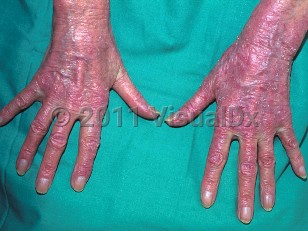Drug-induced photoallergic reaction
Alerts and Notices
Important News & Links
Synopsis

Drug-induced photoallergic reactions are allergic reactions due to ultraviolet light (UVL)-induced alteration of a drug. They are dose independent and do not occur in all patients. Patients typically complain of itching rather than burning, and symptoms tend to be chronic. Common offenders include the following: sunscreens (benzophenones, cinnamates), fragrances (musk ambrette, sandalwood oil), topical antimicrobial agents (chlorhexidine, fenticlor, hexachlorophene), NSAIDs (diclofenac, ketoprofen, piroxicam, celecoxib), phenothiazines (chlorpromazine, promethazine), antiarrhythmics (quinidine), antifungals (griseofulvin), antimalarials (quinine), quinolones (enoxacin, lomefloxacin), sulphonylureas (glipizide), and sulfonamides. Trimethoprim and sulfamethoxazole are common causes in immunosuppressed patients.
Drug-induced photoallergic reactions manifest as red, scaling, pruritic (eczematous) papules and plaques in photodistributed areas (forehead, malar areas, sides of neck, and dorsum of the hands). This eruption is often pruritic and looks like chronic atopic dermatitis with a photodistribution.
Codes
L56.1 – Drug photoallergic response
SNOMEDCT:
69047008 – Drug-induced photosensitivity
Look For
Subscription Required
Diagnostic Pearls
Subscription Required
Differential Diagnosis & Pitfalls

Subscription Required
Best Tests
Subscription Required
Management Pearls
Subscription Required
Therapy
Subscription Required
Drug Reaction Data
Subscription Required
References
Subscription Required
Last Updated:04/19/2018

